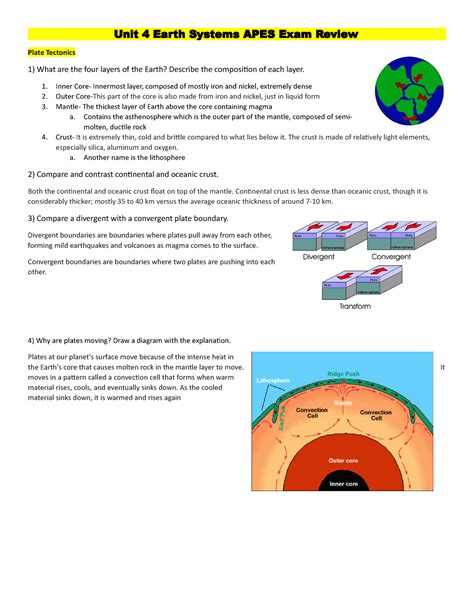Introduction
The Earth’s systems are closely interconnected and impact life on our planet. Understanding these systems is crucial for students taking the AP Environmental Science (APES) exam. This review provides a comprehensive overview of Unit 4, focusing on the Earth’s atmosphere, hydrosphere, lithosphere, and biosphere.

Earth’s Atmosphere
Composition and Structure
- The Earth’s atmosphere is a gaseous envelope surrounding the planet.
- It is composed of 78% nitrogen, 21% oxygen, and 1% other gases.
- The atmosphere is divided into layers based on temperature and composition: troposphere, stratosphere, mesosphere, thermosphere, and exosphere.
Weather and Climate
- Weather refers to short-term atmospheric conditions, while climate describes long-term patterns.
- Factors influencing weather include air temperature, humidity, precipitation, wind, and atmospheric pressure.
- Greenhouse gases in the atmosphere trap heat, leading to climate change.
Air Pollution
- Air pollution is the release of harmful substances into the atmosphere.
- Sources of air pollution include transportation, industrial activities, and energy production.
- Air pollution has severe impacts on human health and the environment.
Earth’s Hydrosphere
Water Resources
- The hydrosphere includes all water on Earth, from oceans to groundwater.
- Oceans cover 71% of the Earth’s surface and contain 97% of the planet’s water.
- Freshwater resources are limited and unevenly distributed, posing challenges for human societies.
Water Cycle
- The water cycle describes the continuous movement of water between the Earth’s surface, atmosphere, and oceans.
- Evaporation, condensation, precipitation, and runoff are key processes in the water cycle.
Water Pollution
- Water pollution occurs when harmful substances are introduced into water bodies.
- Sources of water pollution include industrial waste, agricultural runoff, and sewage.
- Water pollution threatens human health, aquatic ecosystems, and economic activities.
Earth’s Lithosphere
Plate Tectonics
- The lithosphere is the solid, outermost layer of the Earth.
- It is divided into tectonic plates that move over the mantle.
- The movement of tectonic plates causes earthquakes, volcanoes, and mountain formation.
Rock Cycle
- The rock cycle describes the transformation of rocks from one type to another.
- Rocks can be igneous (formed from cooled magma), sedimentary (formed from sediment), or metamorphic (formed from existing rocks under pressure and heat).
Mineral Resources
- Earth’s lithosphere contains valuable mineral resources, such as metals, minerals, and fossil fuels.
- Mining and extraction of these resources have significant environmental and economic implications.
Earth’s Biosphere
Ecosystems and Biomes
- The biosphere includes all living organisms on Earth and their interactions with each other and the environment.
- Ecosystems are communities of living organisms and their physical environment.
- Biomes are large-scale ecosystems characterized by specific climate and vegetation.
Biodiversity
- Biodiversity refers to the variety of living organisms on Earth.
- It includes genetic diversity within species, species diversity, and ecosystem diversity.
- Biodiversity has immense value for human well-being, providing ecosystem services and economic benefits.
Threats to Biodiversity
- Biodiversity is threatened by human activities, such as habitat loss, overexploitation, pollution, and climate change.
- The loss of biodiversity has severe implications for human societies and the future of life on Earth.
Tips for Success on the APES Exam
- Understand the concepts and key terms presented in Unit 4.
- Practice using multiple-choice and free-response questions.
- Utilize online resources and APES textbooks for review.
- Join study groups and engage in discussions with classmates.
- Seek guidance from teachers or advisors for clarification and support.
Conclusion
Unit 4 of the AP Environmental Science exam covers vital aspects of the Earth’s systems. Understanding the interactions between the atmosphere, hydrosphere, lithosphere, and biosphere is crucial for students to succeed on the exam. By studying this material thoroughly and utilizing the tips provided, students can confidently approach the APES exam and demonstrate their knowledge of the Earth’s systems.
